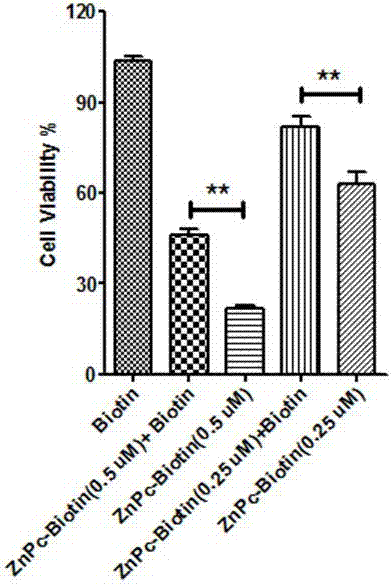A Bilateral Biotin-Phthalocyanine Zinc Conjugate and Its Preparation and Application
A technology of biotin and zinc phthalocyanine, which is applied in drug combination, organic chemistry, and organic chemical methods, can solve the problems of poor tumor selectivity, uncertain structure, and insufficient targeting, and achieve strong tissue penetration and production Effects of low cost, easy separation and purification
- Summary
- Abstract
- Description
- Claims
- Application Information
AI Technical Summary
Problems solved by technology
Method used
Image
Examples
Embodiment 1
[0028] (1) Disperse sodium hydride (18 mg, 0.44 mmol) uniformly in anhydrous THF, then slowly add the THF solution of compound (Ⅳ) (195 mg, 0.20 mmol) into the above reaction solution, stir for a while and then add bromopropyl Alkyne (34 μL, 0.44 mmol), react overnight at 60 °C under nitrogen protection, TLC detects that the reaction is complete, add a small amount of water after the reaction solution is cooled to room temperature, stir for a while, remove THF by rotary evaporation under reduced pressure, and dichloromethane and water Extract, combine the organic phase and wash with anhydrous Na 2 SO 4 Dry, remove the solvent by rotary evaporation under reduced pressure, use dichloromethane-methanol (30:1, v / v) as the eluent, and purify by silica gel column chromatography to obtain blue-green solid compound (II): , (215 mg, 98%); 1 H NMR (400MHz, CDCl 3 and a small amount of C 5 D. 5 N): δ 9.36-9.40 (m, 4 H, Pc-H α ), 9.29 (d, J = 6.8 Hz, 2 H, Pc-H α ), 8.08-8.15 (m,...
PUM
 Login to View More
Login to View More Abstract
Description
Claims
Application Information
 Login to View More
Login to View More - R&D
- Intellectual Property
- Life Sciences
- Materials
- Tech Scout
- Unparalleled Data Quality
- Higher Quality Content
- 60% Fewer Hallucinations
Browse by: Latest US Patents, China's latest patents, Technical Efficacy Thesaurus, Application Domain, Technology Topic, Popular Technical Reports.
© 2025 PatSnap. All rights reserved.Legal|Privacy policy|Modern Slavery Act Transparency Statement|Sitemap|About US| Contact US: help@patsnap.com



